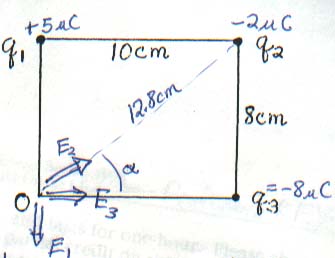
1.) (a) A 150-W light bulb is hooked up to a standard 120-V wall
outlet.
Find the current in the bulb in amperes.
(b) Determine the resistance of the bulb at this level of current.
2.)(a) Copper has a resistivity (r) of 1.68 x
10-6 W
(b) Determine the resistance at 0°C of a copper wirewound resistor
having a resistance of 105 W
3.) For the circuit shown at the right, determine the
equivalent capacitance and the total charge on
it. Also determine the charge and voltage across
each capacitor in the figure.
C1 = 6.0 mF
C2 = 4.0 mF
C3 = 10.0 mF

Ceq = ________ mF Qeq = ________ mC
Q1 = ________ mC V1 = ________ V
Q2 = ________ mC V2 = ________ V
Q3 = ________ mC V3 = ________ V
4.) If a 3 mF capacitor is connected to a 12 V battery, determine the
work done by the battery in charging the capacitor. Also,
determine
how much energy is stored in the capacitor.
5.) (a) Charge q1 = 8 mC is placed 4 cm to the left of charge
q2 =
6 mC. Draw a picture and determine the electrostatic potential at a
point A located 3 cm directly above q1.
(b) Determine the potential energy of this two-charge system.
6.) Determine the electric force (magnitude and direction) on
a
10 mC point charge placed midway between a +5
mC point charge
(left side) and a +3 mC point charge (right side) which are located
10 cm apart.
7.) For the charge configuration shown to the right,
q1 = 5 mC,
q2 = -2 mC, and
q3 = -8 mC. Determine
the resultant electric field (magnitude and direction)
at the fourth corner of the
rectangle.
HINT:
Place the origin of coordinates at this fourth corner.
